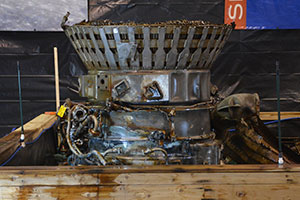 advertisements advertisements
|

|
[Photos] First look at Amazon CEO's historic moon rocket engines
May 21, 2013 — Despite having stood up to the immense thrust needed to launch the mighty Saturn V rocket toward the moon, it turns out that the mammoth F-1 engines that powered the booster's first two-and-a-half minutes of flight were no match for the Atlantic Ocean.
The twisted and tattered components of at least two engines, salvaged from the seafloor by an expedition organized and funded by Amazon.com CEO Jeff Bezos, are set to go on public view in Kansas on Friday (May 24) as conservators work to preserve them for generations of museum-goers to come.
"I personally didn't think the impact with the surface of the ocean would rip the engines apart like it did," Jim Remar, president of the Kansas Cosmosphere and Space Center in Hutchinson, told collectSPACE.com during a preview of the F-1 engines' observation gallery on Monday (May 20)...
Continued: First look at Amazon CEO's historic rocket engines |
|

Photos: collectSPACE.com / Robert Z. Pearlman |

A complete, never flown F-1 engine is displayed outside the Kansas Cosmosphere and Space Center (complete, less its lower nozzle). |

The Cosmosphere's new SpaceWorks Observation Gallery provides an up-close look at conservators at work preserving the F-1 engines. |

Like a space-age sculpture garden, the engine parts are "planted" in large wooden basins. "We set them up and put them in there based on how it was going to fit. It was almost like a puzzle," Cosmosphere president and chief operating officer Jim Remar said. |

A SpaceWorks technician works on cleaning a small part of an F-1 engine. Reflected in the window is the size comparison between a complete F-1 engine and a human, one of the several informational displays included in the observation gallery. |

An Apollo Saturn V F-1 engine thrust chamber. The nozzle would extend from the top, as positioned in the SpaceWorks wooden basin. |

Detail shot of an F-1 engine thrust chamber showing the corrosion, indicating where the chamber had been buried up to in the seafloor. |

An Apollo Saturn V F-1 engine heat exchanger, thrust chamber and turbo pump undergoing conservation. The spray is bathing the parts in freshwater (tap water) to clean off salt and debris from the ocean water. |

One of the displays in the Cosmosphere's SpaceWorks Observation Gallery labeling the parts of an Apollo Saturn V F-1 engine. |

Display boards in the Cosmosphere's SpaceWorks Observation Gallery tell the story of the engines' recovery, raising and conservation. |

Apollo F-1 engine turbo pump components. These pieces display the most corrosion among the parts raised from the Atlantic Ocean floor. |

Apollo F-1 engine heat exchanger and thrust chamber components undergoing conservation by the Cosmosphere's SpaceWorks division. |

Only one Apollo Saturn V F-1 engine nozzle, or bell, was recovered as a spaghetti-like mound of tubes and metal strips. |

A SpaceWorks technician works to disassemble and clean a small part from a recovered Apollo Saturn V F-1 engine. |

The SpaceWorks Observation Gallery offers a close-up view of the conservators at work, set against a backdrop of larger engine parts. |
|

© collectSPACE. All rights reserved.
|
|

|

|
